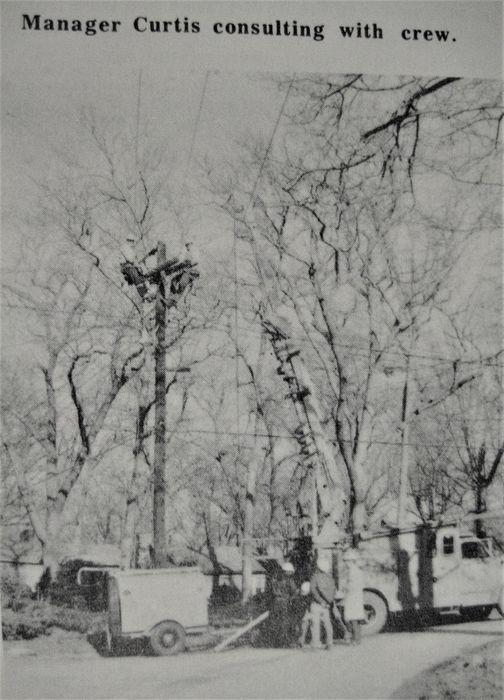Hingham Municipal Lighting Plant, MA, 1955-1957, Line Crew, Portable Transformer Unit
By Joe Maurath, Jr.; posted August 26, 2020
View Original: Click to zoom, then click to magnify (2212 x 3072) 2066KB

|
Upon transferring transformers and keeping the customers' lights on, "Bibby" was used by this utility. Basically, Bibby was a small enclosed trailer with a single phase 4kv transformer inside of it. Well insulated primary and secondary cables led up the pole from this "portable transformer" station. Bibby also was used at nights when a transformer failed. He was hooked up via the troubleman bypassing the defective transformer's connections so power could be restored. Bibby had red lights all around him so that while unattended he could be safely seen well into the distance. During such transformer outages Bibby restored service and first thing the next day the line crew would make permanent repairs with a new transformer placed on the pole. "Bibby" can be seen here on the far left and was named after a long-time 1920s-1940s light plant employee. Mr. Bibby always had a single phase transformer secured in back of this pickup truck ready at all times for emergency situations. Mr. Bibby apparently sat with his truck at the outage location with his temporary connections until the next day when crews arrived. I do not know when Mr. Bibby retired. But I understand the portable arrangement seen here was built soon after he (and this truck) ended their service with the town utility (probably in the 1950s). The newer Bibby continued in service among the light plant's fleet until the the mid-1990s when the town completed its 4kv to 13.8kv primary distribution voltage conversion. Twisted "Tri-plex" cable was first used by the Hingham utility beginning right around 1955. Solid bare copper strand cable was used for the neutral and the two conductors were rubber covered copper. This method of customer service drops gradually replaced deteriorating and troublesome cloth-covered enclosed cable that ran from poles to customers (this was much like service-entrance cable) and other still-existing obsolete customer service lines including open wire drops. All Tri-plex cable used in Hingham has been copper and use of it continues to this day. Its advantages are strength, ultimate conductivity and being salt-corrosion resistant (the town has a fair amount of coastline). Further, *all* overhead and underground conductors in that town are copper and always have been for the same reasons. There has never been a stitch of alunimum wire anywhere on the system... Triplex for secondary distribution along streets was adopted in the mid 1960s. During 1955-57 the Light Plant began using steel pins exclusively on all crossarms, openwire. Typically primaries for new construction were strung on six-pin arms and four-pin crossarms were the standard for secondaries (openwire was still being used).. All of Hingham was connected to the Weymouth Light and Power Company at several points and 23kv to 4kv substations were at these locations. The electricity source for the Hull Municipal Lighting Plant (an adjoining town) was served by the forementioned company's 23kv lines. Since these two circuits passed right through the middle of Hingham, a feasability study commenced during 1955 to determine if both light departments could jointly own the line and together become one municipal utility. The Light Board commissioners in Hull voted the idea down in 1957. Consequently the two utilities have remained separate and the 23kv line (with origins going back to the teens) still stands. The latter is now owned by National Grid and extends to the Hull, MA town line (the town's lines begin there and have been fully modernized and updated). Much of the National Grid conductor from the 1930s and earlier is still in the air along with numerous "K-frame" and cedar poles from the 1930s. Outages often take place along it during windstorms owing to falling trees and the old-school architecture that adorns it. During 1957 Mr. Clyde H. Curtis became general manager of the Hingham Light Plant. He began his career with the utility in 1941 digging pole holes. Soon thereafter he entered the line department. Clyde absolutely loved line work! His nickname was "Boomer" and used this as his CB radio handle. He was born in Hingham and the townspeople adored him. He was quite innovative and retired in 1981. He is seen here with one of his line crews during the late 1950s or early 1960s (he is the gentleman in the long white coat). |